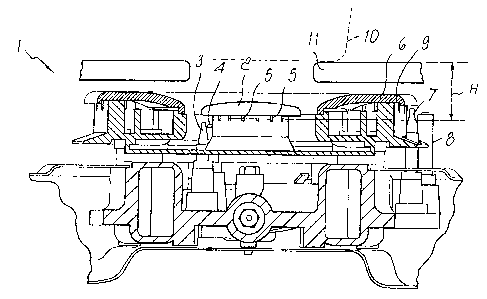Some of the information on this Web page has been provided by external sources. The Government of Canada is not responsible for the accuracy, reliability or currency of the information supplied by external sources. Users wishing to rely upon this information should consult directly with the source of the information. Content provided by external sources is not subject to official languages, privacy and accessibility requirements.
Any discrepancies in the text and image of the Claims and Abstract are due to differing posting times. Text of the Claims and Abstract are posted:
| (12) Patent Application: | (11) CA 2486610 |
|---|---|
| (54) English Title: | BURNER FOR GAS COOKING RANGES |
| (54) French Title: | BRULEUR POUR CUISINIERES A GAZ |
| Status: | Deemed Abandoned and Beyond the Period of Reinstatement - Pending Response to Notice of Disregarded Communication |
| (51) International Patent Classification (IPC): |
|
|---|---|
| (72) Inventors : |
|
| (73) Owners : |
|
| (71) Applicants : |
|
| (74) Agent: | ROBIC AGENCE PI S.E.C./ROBIC IP AGENCY LP |
| (74) Associate agent: | |
| (45) Issued: | |
| (22) Filed Date: | 2004-11-03 |
| (41) Open to Public Inspection: | 2005-11-03 |
| Examination requested: | 2009-10-30 |
| Availability of licence: | N/A |
| Dedicated to the Public: | N/A |
| (25) Language of filing: | English |
| Patent Cooperation Treaty (PCT): | No |
|---|
| (30) Application Priority Data: | ||||||
|---|---|---|---|---|---|---|
|
A gas-fired burner for cooking range, which includes at least one burner,
which is
arranged below at least one grate on which a cooking vessel is to be arranged,
the
distance between the nozzles of the burner and the upper surface of the grate
being
directly proportional to the power of the burner and being inversely
proportional to the
difference between the temperature of the burner and the temperature of the
vessel and
to the heat conductivity of the vessel and/or food contained therein.
Note: Claims are shown in the official language in which they were submitted.
Note: Descriptions are shown in the official language in which they were submitted.

2024-08-01:As part of the Next Generation Patents (NGP) transition, the Canadian Patents Database (CPD) now contains a more detailed Event History, which replicates the Event Log of our new back-office solution.
Please note that "Inactive:" events refers to events no longer in use in our new back-office solution.
For a clearer understanding of the status of the application/patent presented on this page, the site Disclaimer , as well as the definitions for Patent , Event History , Maintenance Fee and Payment History should be consulted.
| Description | Date |
|---|---|
| Application Not Reinstated by Deadline | 2013-06-05 |
| Inactive: Dead - Final fee not paid | 2013-06-05 |
| Deemed Abandoned - Failure to Respond to Maintenance Fee Notice | 2012-11-05 |
| Deemed Abandoned - Conditions for Grant Determined Not Compliant | 2012-06-05 |
| Notice of Allowance is Issued | 2011-12-05 |
| Letter Sent | 2011-12-05 |
| Notice of Allowance is Issued | 2011-12-05 |
| Inactive: Approved for allowance (AFA) | 2011-11-03 |
| Letter Sent | 2010-12-08 |
| Reinstatement Requirements Deemed Compliant for All Abandonment Reasons | 2010-11-26 |
| Deemed Abandoned - Failure to Respond to Maintenance Fee Notice | 2010-11-03 |
| Inactive: Correspondence - MF | 2010-08-10 |
| Letter Sent | 2010-05-19 |
| Letter Sent | 2010-05-19 |
| Inactive: Single transfer | 2010-04-21 |
| Letter Sent | 2009-12-15 |
| Amendment Received - Voluntary Amendment | 2009-11-18 |
| Request for Examination Requirements Determined Compliant | 2009-10-30 |
| All Requirements for Examination Determined Compliant | 2009-10-30 |
| Request for Examination Received | 2009-10-30 |
| Application Published (Open to Public Inspection) | 2005-11-03 |
| Inactive: Cover page published | 2005-11-02 |
| Letter Sent | 2005-09-12 |
| Inactive: Single transfer | 2005-07-08 |
| Inactive: First IPC assigned | 2005-02-17 |
| Inactive: Courtesy letter - Evidence | 2005-01-04 |
| Inactive: Filing certificate - No RFE (English) | 2004-12-30 |
| Filing Requirements Determined Compliant | 2004-12-30 |
| Application Received - Regular National | 2004-12-30 |
| Abandonment Date | Reason | Reinstatement Date |
|---|---|---|
| 2012-11-05 | ||
| 2012-06-05 | ||
| 2010-11-03 |
The last payment was received on 2011-09-27
Note : If the full payment has not been received on or before the date indicated, a further fee may be required which may be one of the following
Please refer to the CIPO Patent Fees web page to see all current fee amounts.
| Fee Type | Anniversary Year | Due Date | Paid Date |
|---|---|---|---|
| Application fee - standard | 2004-11-03 | ||
| Registration of a document | 2005-07-08 | ||
| MF (application, 2nd anniv.) - standard | 02 | 2006-11-03 | 2006-11-01 |
| MF (application, 3rd anniv.) - standard | 03 | 2007-11-05 | 2007-10-30 |
| MF (application, 4th anniv.) - standard | 04 | 2008-11-03 | 2008-11-03 |
| Request for examination - standard | 2009-10-30 | ||
| MF (application, 5th anniv.) - standard | 05 | 2009-11-03 | 2009-11-02 |
| Registration of a document | 2010-04-21 | ||
| MF (application, 6th anniv.) - standard | 06 | 2010-11-03 | 2010-11-26 |
| Reinstatement | 2010-11-26 | ||
| MF (application, 7th anniv.) - standard | 07 | 2011-11-03 | 2011-09-27 |
Note: Records showing the ownership history in alphabetical order.
| Current Owners on Record |
|---|
| FULGOR S.R.L. |
| Past Owners on Record |
|---|
| DAVID WARD |
| ORIO PURICELLI |